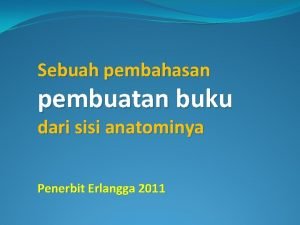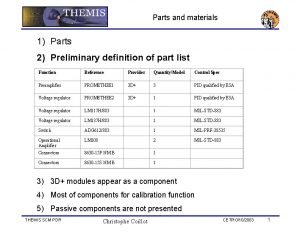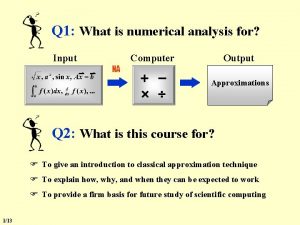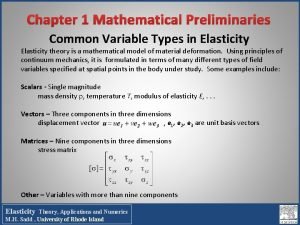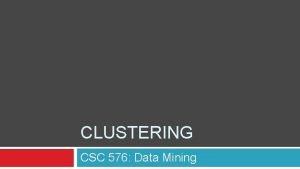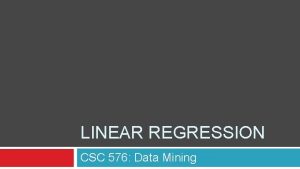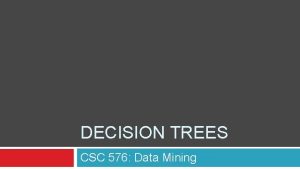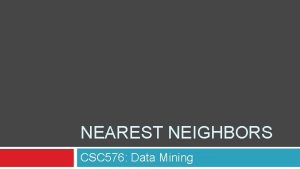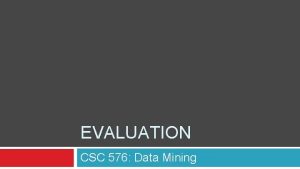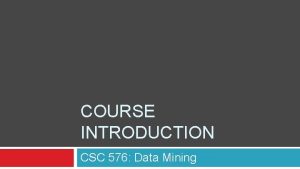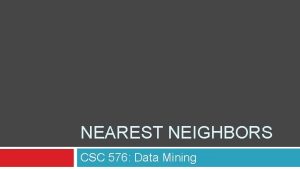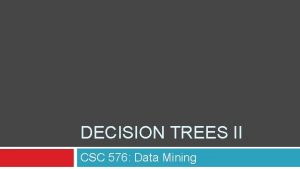DATA PRELIMINARIES CSC 576 Data Mining Today Types











- Slides: 11

DATA PRELIMINARIES CSC 576: Data Mining

Today Types of Data Quality Exploring Data: Summary Statistics, Visualizations

What is Data? Collection of data objects and their attributes An attribute is a property or characteristic of an object � � Examples: eye color of a person, temperature, etc. Attribute is also known as Objects variable, field, characteristic, or feature A collection of attributes describe an object � Object is also known as record, point, case, sample, entity, or instance Attributes

Attribute Values Attribute values are numbers or symbols assigned to an attribute Distinction between attributes and attribute values � Same attribute can be mapped to different attribute values � Example: height can be measured in feet or meters Different attributes can be mapped to the same set of values Example: Attribute values type for both “ID” and “age” are integers But properties of attribute values can be different ID has no limit but age has a maximum and minimum value

Different Types of Attributes 1. Nominal / Categorical � Examples: 2. Ordinal � Examples: 3. rankings, size in {small, medium, large} Interval � Examples: 4. ID numbers, eye color, zip codes calendar dates Ratio � Examples: counts, time

Properties of Attribute Values The type of an attribute depends on which of the properties it possesses Nominal Eye color =≠ Ordinal Size {small, medium, large} =≠ <>≤≥ Interval Calendar dates =≠ <>≤≥ +− Ratio Counts, time =≠ <>≤≥ +− ×÷

Ordinal vs. Interval vs. Ratio Ordinal � � Interval � � � Order matters, but not the difference between values Difference between 7 and 5 may not be same as difference between 5 and 3 Difference between two values is meaningful 100 degrees – 90 degrees is same difference as 90 degrees – 80 degrees Temperature of 100 degrees is not twice as hot as 50 degrees Ratio � � Clear definition of 0. 0; none of a variable at 0. 0 Weight of 8 grams is twice the weight of 4 grams (Temperature 100 Kelvin is twice as hot as 50 Kelvin; Kelvin is Ratio; 0. 0

Discrete and Continuous Attributes Discrete Has finite attribute values Often represented as integer variables Examples: zip codes, counts, {1, 2, 3, …} (Note: binary 0/1 attributes are special case of discrete. ) Continuous Has real numbers as attribute values Often represented as doubles (floating-pt variables) Examples: height, temperature, 3. 14159 (Practically, real values can only be measured and represented using a finite number of digits)

Ordered Data Temporal Data � Each record has a time associated with it Example: retail transaction Sequential Data � Dataset has sequence of individual entities (such as sequence of words or letters) Example: DNA sequence (ATGC possible letters)

Ordered Data Time Series � Series of measurements taken over time � Example: financial stock price data Temporal autocorrelation: if two measurements are close in time, then the value of those measurements are often very similar Spatial Data � Each record has a position or area � Example: geographical locations Spatial autocorrelation: objects that are physically close tend to be similar

References Fundamentals of Machine Learning for Predictive Data Analytics, 1 st Edition, Kelleher et al. Introduction to Data Mining, 1 st edition, Tan et al.
 Mining complex types of data in data mining
Mining complex types of data in data mining Multimedia data mining
Multimedia data mining Apa itu preliminaries
Apa itu preliminaries Preliminary material
Preliminary material Halaman preliminaries
Halaman preliminaries Mathematical preliminaries in numerical computing
Mathematical preliminaries in numerical computing Chapter 1 mathematical preliminaries
Chapter 1 mathematical preliminaries Collect synoynm
Collect synoynm Mining complex types of data
Mining complex types of data Complex data types in data mining
Complex data types in data mining Strip mining vs open pit mining
Strip mining vs open pit mining Chapter 13 mineral resources and mining
Chapter 13 mineral resources and mining


